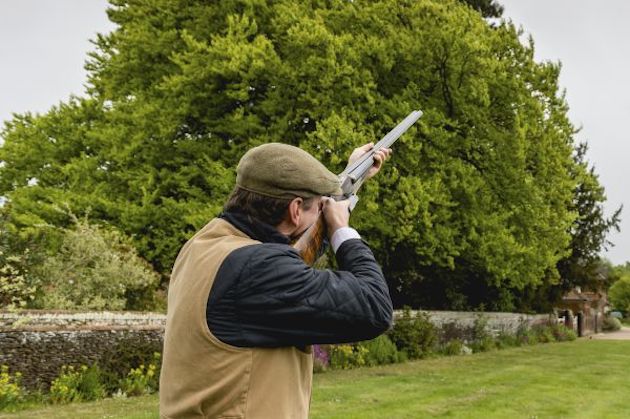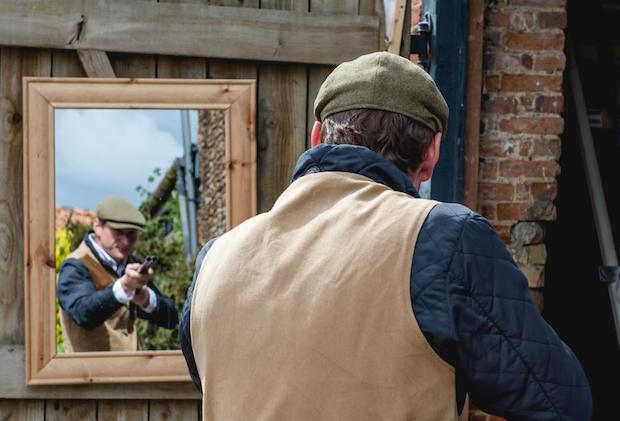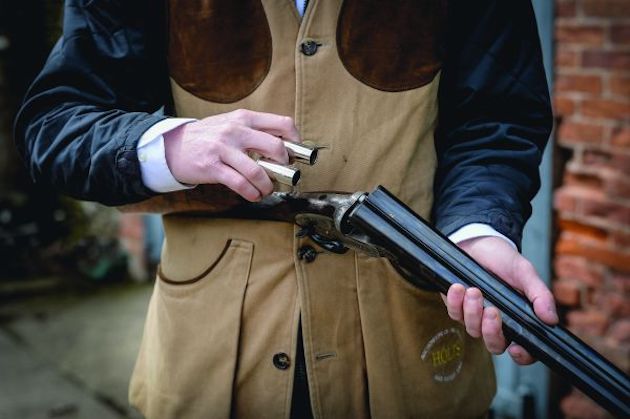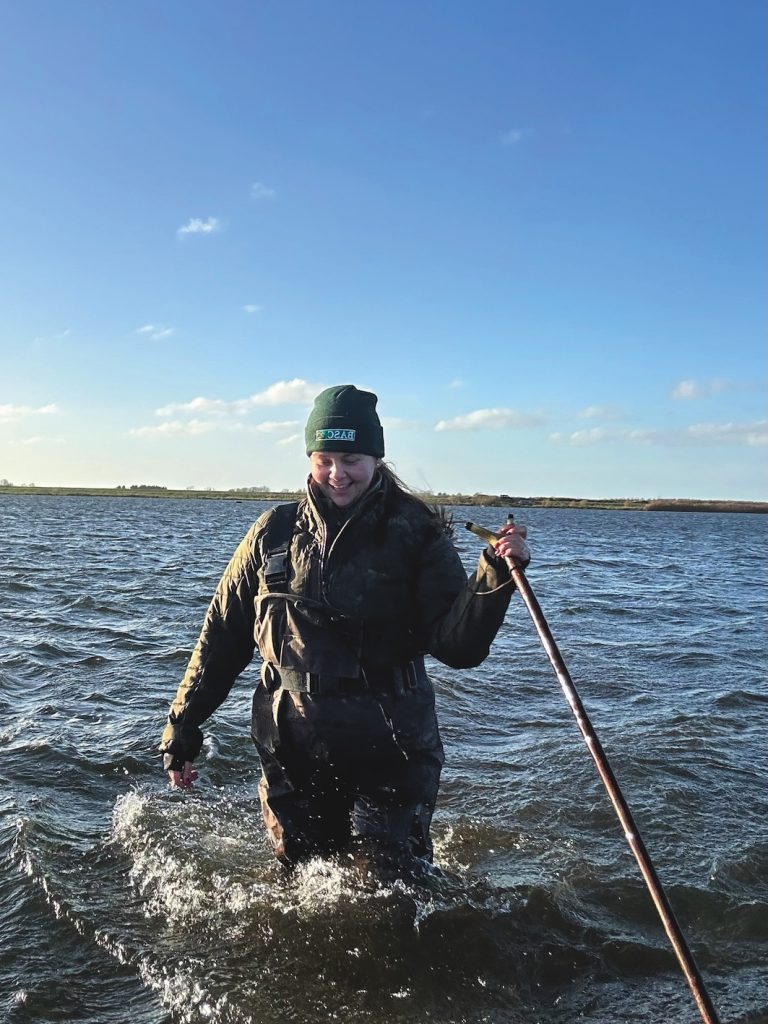Win CENS ProFlex DX5 earplugs worth £1,149 – enter here
How to practice your shooting during lockdown
Many of us have a lot of time on our hands at the moment so why not get some shooting practice in at home, suggests Simon Reinhold

There is a lot you can achieve by practising shooting during lockdown to keep your eye in, ready for your return to pulling the trigger. Areas you can work on without even firing a shot include gun mount, footwork, vision and technique.
Practising shooting during lockdown
Gun mount is one of the most effective and one where you can see real benefits quickly. First, establish the gun is unloaded and then set yourself up 2m away from a mirror. Start by placing the gun in your shoulder and your head on the stock, and pointing the bead at your eyeball in the reflection. For most game shooters you want to see the eyeball resting on the rib. If it doesn’t, your gunfit should be checked by a coach when lockdown ends.
Assuming it does fit, bring your gun down from your shoulder pocket and mount the gun 10 times in a row, trying to get your eyeball to sit perfectly on the rib each time. A small adjustment is not unusual in the first few sessions. What you are looking for is for both hands to be working in unison — the muzzle and stock of the gun should rise together as you mount it. Your shoulder should move forward a little, but your head should remain still and they should all lock firmly but smoothly together at the same time.
If you find your stock hand is doing more work, your muzzles will dip below the horizontal. You can rectify this by controlling the stock under your armpit. This forces your barrel hand to push forward rather than up.
With your newly refreshed gun mount, point to the corner of the wall and ceiling — just before the gun locks with your shoulder and cheek, close your eyes. Open them again when it is in your shoulder and you should be pointing at the corner.
Focus
Once you have practised this, you can move on to following the lines of the ceiling. These natural flow lines can help you visualise that fluidity inherent in good shooting. You can tape a small torch to the side/bottom rib and close the curtains to focus on the ‘bird’ but retain barrel awareness, if it helps. You are looking to ride two horses with your focus; the right level of attention but in a relaxed manner. Focus too hard and you tighten up; too soft and careless mistakes come into your gun mount.

Use a mirror to help improve your gun mount – you want to see your eyeball resting on the rib
Footwork
This can be done in a secluded garden — don’t upset the neighbours, though. My preferred method is to use snap caps and to trace passing pigeons and corvids. I spent hours doing this as a youth when shooting opportunities were limited, carving out synaptic pathways in the brain like water running over rock.
Contrary to popular belief, muscles don’t have memory. Specific parts of your brain control which signals your muscles act upon and this is where these movements become second nature; your muscles’ strength and fitness to carry them out is also improved. But to do all of this well, your footwork needs to be sound.
The adage of pointing your lead foot to where you want to kill the bird is fine for quick reaction shooting, but when shooting higher birds to left and right you can take advantage of the more time available.
Pick a point in the middle of the ceiling line where you want to kill the bird. Instead of simply pointing your lead foot at that point and pivoting the ball of the other foot, bring your back foot round to point in a similar direction. Start on the corner and come through the kill point.
You will feel restricted in the movement at the start of the swing and your knees may twist, but the essential follow-through will feel freer. If that is unfamiliar, stick with what you know. Do 10 repetitions a day then increase the number until you start to feel it in the muscles of the arms. Once you’ve practised a few days, change it up to swing one side of the room and turn 180° and immediately swing on the other ceiling line. If you get it wrong you won’t be able to hold the line.

Snap caps allow you to pull the trigger without using live ammunition
Core
A good gun swing comes from the ground up. Your footwork and balance are crucial elements, but the motion itself should not come from the arms. Your arms are there to mount the gun consistently and keep it on line. The swing itself should come from your core — the spot in the middle of your body, just below the navel, is its centre. It’s known in martial arts as the ‘tanden’ or ‘hara’ and it is where your physical power comes from.
Try swinging a gun with just your arms then include hip rotation — your hips and pelvis surround your hara — to see the difference in power and effort. Almost all your body is used in the perfect gun swing.
Fieldsports specialists have been generous with their time and expertise during this lockdown. Some of it is in the form of Instagram live broadcasts and some can be found on YouTube.We have two choices: we can take positive steps to keep ourselves fit and come back shooting stronger than ever, or we can focus on the negatives. I know which I prefer.
Eyesight is key for shooting and staring at your phone during lockdown won’t have helped. There are exercises available online but, with such a sensitive body part for shooting, I prefer to consult a specialist. Ed Lyons, the ‘go-to’ vision specialist for many top shooters, has developed some eye training kits with several options for home use.
With any muscle, it is important to warm it up before training. Ed suggests the following: sit or stand in a relaxed position. Hold a pen about 6in from your face. Keeping your head still, move the pen slowly to the right and follow it with your eyes until you can go no further. Come back to the centre. Then repeat smoothly to the left, and back to centre. Then up and down, always coming smoothly back to centre. Then move on to the diagonals, coming back to centre again. Once you have completed all directions, repeat, but this time hold the stretch for a count of four.
“The muscles in your eyes are the most active in your body,” says Ed. “The accuracy with which you see the target dictates how you move to shoot it.”
This warm-up is useful in itself but is designed to be used with the kits that can help with eye dominance issues, improve your eye co-ordination and increase your ability to focus on near and far objects on demand
Related Articles
Get the latest news delivered direct to your door
Subscribe to Shooting Times & Country
Discover the ultimate companion for field sports enthusiasts with Shooting Times & Country Magazine, the UK’s leading weekly publication that has been at the forefront of shooting culture since 1882. Subscribers gain access to expert tips, comprehensive gear reviews, seasonal advice and a vibrant community of like-minded shooters.
Save on shop price when you subscribe with weekly issues featuring in-depth articles on gundog training, exclusive member offers and access to the digital back issue library. A Shooting Times & Country subscription is more than a magazine, don’t just read about the countryside; immerse yourself in its most authoritative and engaging publication.







